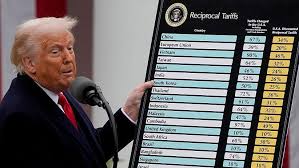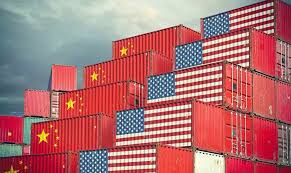Battleground
Trump’s Tariffs during his presidency, Donald Trump turned global trade policy into a battleground. At the heart of his approach? Tariffs, a classic economic tool rebranded as political leverage. In this post, we break down what Trump’s tariffs were, why he imposed them, and how they impacted both the U.S. and global economy.
What Did Tariffs Mean to Trump?
For President Trump, tariffs weren’t just taxes on imports, they were weapons. A key part of his “America First” agenda, tariffs were used to punish what he called “unfair trade practices,” particularly by China, and to gain leverage in trade negotiations.
Trump repeatedly framed trade wars as battles the U.S. could easily win, famously tweeting:
“Tariffs are the greatest!”
“Trade wars are good and easy to win.”
His key goals with tariffs included:
- Reducing the U.S. trade deficit
- Reviving domestic manufacturing
- Responding to China’s alleged intellectual property theft and forced tech transfers

Trump’s Major Tariff Actions: A Timeline
Here are some of the biggest moves during Trump’s tariff-heavy trade strategy:
Steel & Aluminum (March 2018)
- 25% tariffs on steel, 10% on aluminum
- Applied to key allies: the EU, Mexico, Canada
- These countries retaliated by targeting U.S. exports like Harley-Davidson motorcycles, bourbon, and Levi’s jeans
Tariffs on China (July 2018 onward)
- Initially: $34 billion worth of goods
Eventually expanded to over $360 billion in Chinese imports
Targeted everything from electronics to toys and furniture
- China hit back with tariffs on $110 billion worth of American goods, including soybeans, pork, and autos
Trade War Fallout: The Real-World Effects
The trade war caused ripples and in some cases, waves across sectors:
U.S. Farmers Took a Hit
China stopped buying U.S. soybeans, leading to huge losses. The federal government stepped in with $28 billion in aid to farmers (2018–2020) to ease the blow.
Manufacturers Faced Rising Costs
Tariffs on imported metals raised production costs for many American manufacturers:
- Whirlpool increased appliance prices after steel tariffs
- Automakers saw costs spike, with limited ability to pass them on to consumers
Consumers Paid More
A study by the Federal Reserve estimated that the tariffs cost the average U.S. household $1,277 per year, due to increased prices on imported goods and supply chain disruptions.

Did Trump’s Tariffs Work?
Let’s look at the numbers.
Trade Deficit Grew
Despite efforts to shrink it, the U.S. trade deficit rose under Trump:
- 2016: $502 billion
- 2019: $577 billion
GDP Growth Slowed
- 2018: 2.9%
- 2019: 2.3%
Several institutions, including the IMF and the Federal Reserve, cited tariffs as a drag on growth.
Job Shifts Were Uneven
While some jobs were gained in steel production (about 4,000), others were lost in export-heavy industries hit by retaliatory tariffs.
Political Messaging and Support Base
Trump’s tariff strategy was popular with parts of his base, particularly in Midwestern states with strong manufacturing and agricultural ties.
The “America First” narrative aligned well with promises to protect blue-collar jobs, even though economists warned the real costs fell on American businesses and consumers—not China.
Trump repeatedly insisted:
“China is paying for it!”
But in reality, importers and consumers bore most of the financial burden.
Where Are We Now?
While President Biden has criticized Trump’s trade policy, most of the China tariffs remain in place today.
Key updates:
- The U.S.–China Phase One trade deal (2020) committed China to increase purchases of U.S. goods—but it failed to meet targets
- Companies have restructured supply chains, moving production to countries like Vietnam and Mexico to avoid tariffs
- Tariffs have become a long-term feature of the U.S.–China economic rivalry
Final Thoughts
Trump’s tariffs were a bold and polarizing move. Supporters saw them as a needed correction to decades of perceived trade imbalances. Critics argued they hurt U.S. consumers and strained alliances.
So, what do you think?
- Were the tariffs a smart negotiating tactic—or did they backfire?
- Should future U.S. administrations continue using tariffs as leverage?
- How can the U.S. compete with China without triggering economic fallout?
References
- Federal Reserve Bank. (2019). Economic effects of tariffs. https://www.federalreserve.gov/
- Peterson Institute for International Economics. (2020). Trump’s trade war timeline: An up-to-date guide. https://www.piie.com/research/trade-investment/trump-trade-war-china-date-guide
- U.S. Census Bureau. (2020). Foreign trade: Data. https://www.census.gov/foreign-trade/data/index.html
- U.S. Department of Agriculture. (2020). Trade aid payments under the Market Facilitation Program. https://www.farmers.gov/manage/mfp
- U.S. Trade Representative. (2020). Economic and trade agreement between the United States of America and the People’s Republic of China: Phase one. https://ustr.gov/sites/default/files/files/agreements/phase%20one%20agreement/Economic_And_Trade_Agreement_Between_The_United_States_And_China_Text.pdf
- International Monetary Fund. (2019). World economic outlook: Global manufacturing downturn, rising trade barriers. https://www.imf.org/en/Publications/WEO/Issues/2019/10/01/world-economic-outlook-october-2019
Want to Learn More? Download The Two Blokes Trading APP


